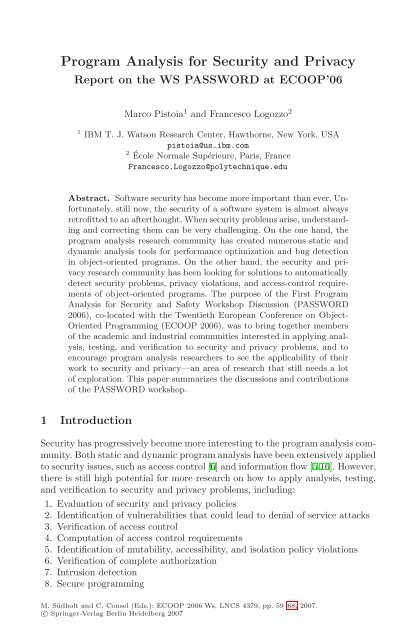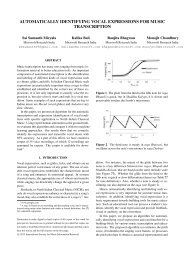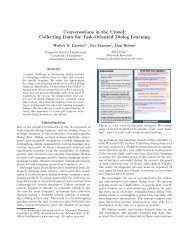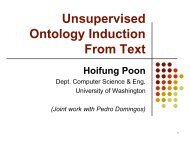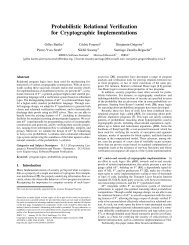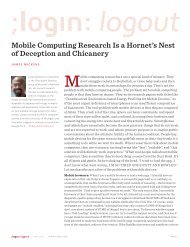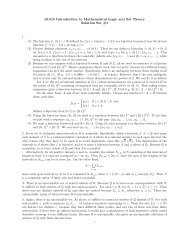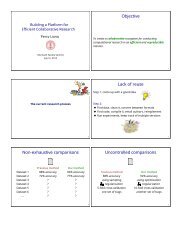PDF file - Microsoft Research
PDF file - Microsoft Research
PDF file - Microsoft Research
Create successful ePaper yourself
Turn your PDF publications into a flip-book with our unique Google optimized e-Paper software.
Program Analysis for Security and Privacy<br />
Report on the WS PASSWORD at ECOOP’06<br />
Marco Pistoia 1 and Francesco Logozzo 2<br />
1 IBM T. J. Watson <strong>Research</strong> Center, Hawthorne, New York, USA<br />
pistoia@us.ibm.com<br />
2 École Normale Supérieure, Paris, France<br />
Francesco.Logozzo@polytechnique.edu<br />
Abstract. Software security has become more important than ever. Unfortunately,<br />
still now, the security of a software system is almost always<br />
retrofitted to an afterthought. When security problems arise, understanding<br />
and correcting them can be very challenging. On the one hand, the<br />
program analysis research community has created numerous static and<br />
dynamic analysis tools for performance optimization and bug detection<br />
in object-oriented programs. On the other hand, the security and privacy<br />
research community has been looking for solutions to automatically<br />
detect security problems, privacy violations, and access-control requirements<br />
of object-oriented programs. The purpose of the First Program<br />
Analysis for Security and Safety Workshop Discussion (PASSWORD<br />
2006), co-located with the Twentieth European Conference on Object-<br />
Oriented Programming (ECOOP 2006), was to bring together members<br />
of the academic and industrial communities interested in applying analysis,<br />
testing, and verification to security and privacy problems, and to<br />
encourage program analysis researchers to see the applicability of their<br />
work to security and privacy—an area of research that still needs a lot<br />
of exploration. This paper summarizes the discussions and contributions<br />
of the PASSWORD workshop.<br />
1 Introduction<br />
Security has progressively become more interesting to the program analysis community.<br />
Both static and dynamic program analysis have been extensively applied<br />
to security issues, such as access control [6] and information flow [5,16]. However,<br />
there is still high potential for more research on how to apply analysis, testing,<br />
and verification to security and privacy problems, including:<br />
1. Evaluation of security and privacy policies<br />
2. Identification of vulnerabilities that could lead to denial of service attacks<br />
3. Verification of access control<br />
4. Computation of access control requirements<br />
5. Identification of mutability, accessibility, and isolation policy violations<br />
6. Verification of complete authorization<br />
7. Intrusion detection<br />
8. Secure programming<br />
M. Südholt and C. Consel (Eds.): ECOOP 2006 Ws,<br />
LNCS 4379, pp. 59–68, 2007.<br />
c○ Springer-Verlag Berlin Heidelberg 2007
60 M. Pistoia and F. Logozzo<br />
This paper summarizes the contributions of the First Program Analysis for Security<br />
and Safety Workshop Discussion (PASSWORD 2006), co-located with<br />
the Twentieth European Conference on Object-Oriented Programming (ECOOP<br />
2006), which was held in Nantes, France in July 2006.<br />
2 Objective and Call for Papers<br />
With the advent of the Internet, software security has become more important<br />
than ever. Unfortunately, still now, the security of a software system is almost<br />
always an afterthought. When security problems arise, understanding and correcting<br />
them can be very challenging. On the one hand, the program analysis<br />
research community has created numerous static and dynamic analysis tools for<br />
performance optimization and bug detection in object-oriented programs. On<br />
the other hand, the security and privacy research community has been looking<br />
for solutions to automatically detect security problems, privacy violations, and<br />
access-control requirements of object-oriented programs. The purpose of PASS-<br />
WORD 2006 was to bring together members of both these communities and to<br />
encourage program analysis researchers to see the applicability of their work to<br />
security and privacy—an area of research that still needs exploration.<br />
Two types of papers were welcomed at PASSWORD 2006: technical papers,<br />
which present mature technical and research material, and position, exploratory,<br />
or preliminary-work papers, which may describe work in progress or new research<br />
ideas.<br />
Topics of interest for PASSWORD included, but were not limited to:<br />
– Analysis of cryptographic systems and implementations<br />
– Analysis of network and security protocols<br />
– Automatic detection of attacks against networks and machines<br />
– Automated tools for source- and compiled-code analysis<br />
– Authentication and authorization of users, systems, and applications<br />
– Bug finding<br />
– Detection of mutability, accessibility, and isolation policy violations<br />
– Identification of denial-of-service attacks<br />
– Input validation<br />
– Intrusion and anomaly detection<br />
– Language-based security<br />
– Operating system security<br />
– Privacy analysis<br />
– Security in heterogeneous and large-scale environments<br />
– Security in the presence of agents and mobile code<br />
– Security policy analysis<br />
– Static analysis for program verification<br />
– Static analysis techniques for soundness, precision, and scalability
Program Analysis for Security and Privacy 61<br />
3 Program Organization and Participants<br />
3.1 Organizers<br />
PASSWORD 2006 was organized by Marco Pistoia and Francesco Logozzo.<br />
– Marco Pistoia, Ph. D. is a <strong>Research</strong> Staff Member in the Programming<br />
Languages and Software Engineering Department at the IBM T. J. Watson<br />
<strong>Research</strong> Center in Hawthorne, New York, USA. He has written ten books,<br />
<strong>file</strong>d thirteen patents, and published numerous papers and journal articles<br />
on all areas of Java and program analysis for security. Most recently, he has<br />
published his Ph.D. thesis, and has been the lead author of the books Enterprise<br />
Java Security, published by Addison-Wesley in 2004 (and now available<br />
in Chinese), and Java 2 Network Security, published by Prentice Hall PTR<br />
in 1999. He has published and presented at several conferences worldwide<br />
and has been invited to give lectures and teach at several universities and<br />
research centers. He received his Ph. D. in Mathematics from Polytechnic<br />
University, Brooklyn, New York in May 2005 with a thesis entitled A Unified<br />
Mathematical Model for Stack- and Role-Based Authorization Systems, and<br />
his Master of Science and Bachelor of Science degrees in Mathematics summa<br />
cum laude from the University of Rome, Italy in 1995, with a research thesis<br />
entitled Theory of Reductive Algebraic Groups and Their Representations.<br />
– Francesco Logozzo, Ph. D. is a Postdoctoral <strong>Research</strong>er at the École<br />
Normale Supérieure, Paris, France. He graduated from École Polytechnique,<br />
Paris, France in June 2004 with a thesis entitled Modular Static Analysis<br />
of Object-oriented Languages. His Ph. D. advisor was Dr. Radhia Cousot.<br />
He was a former student of the Scuola Normale Superiore of Pisa, Italy. He<br />
is the author of more than ten papers on static analysis of object-oriented<br />
languages. He co-chaired the First Workshop on Abstract Intepretation of<br />
Object-Oriented Languages (AIOOL 2005) and the Seventh Workshop of<br />
Formal Techniques for Java-like Programs (FTfJP 2005).<br />
3.2 Program Committee Members<br />
The committee members were program analysis and security experts from<br />
academia and industry:<br />
– Sabrina De Capitani Di Vimercati, University of Milan, Milan, Italy<br />
– Stephen J. Fink, IBM T. J. Watson <strong>Research</strong> Center, Hawthorne, New<br />
York, USA<br />
–RobertJ.Flynn, Polytechnic University, Brooklyn, New York, USA<br />
– Charles Hymans, European Aeronautic Defence and Space Company, Paris,<br />
France<br />
– Trent Jaeger, Pennsylvania State University, University Park, Pennsylvania,<br />
USA<br />
– Francesco Logozzo, École Normale Supérieure, Paris, France<br />
–NasirMemon, Polytechnic University, Brooklyn, New York, USA
62 M. Pistoia and F. Logozzo<br />
– Greg Morrisett, Harvard University, Cambridge, Massachusetts, USA<br />
–David A. Naumann, Stevens Institute of Technology, Hoboken, New<br />
Jersey, USA<br />
–MarcoPistoia, IBM T. J. Watson <strong>Research</strong> Center, Hawthorne, New York,<br />
USA<br />
–JanVitek, Purdue University, West Lafayette, Indiana, USA<br />
–EranYahav, IBM T. J. Watson <strong>Research</strong> Center, Hawthorne, New York,<br />
USA<br />
–SteveZdancewic, University of Pennsylvania, Philadelphia, Pennsylvania,<br />
USA<br />
– Xiaolan Zhang, IBM T. J. Watson <strong>Research</strong> Center, Hawthorne, New York,<br />
USA<br />
– Roberto Zunino, University of Pisa, Pisa, Italy<br />
3.3 Participants<br />
Participation to the PASSWORD 2006 workshop was allowed also through remote<br />
connection for people unable to attend in person. The list of participants<br />
included:<br />
– Paolina Centonze, IBM T. J. Watson <strong>Research</strong> Center, Hawthorne, New<br />
York, USA<br />
– Tzi-cker Chiueh, Computer Science Department, Stony Brook University,<br />
Stony Brook, New York, USA<br />
– Holger Grandy, University of Augsburg, Augsburg, Germany<br />
– Francesco Logozzo, École Normale Supérieure, Paris, France<br />
–YiLu, School of Computer Science and Engineering, The University of New<br />
South Wales, Sydney, Australia<br />
– Eric Madelaine, INRIA, Centre Sophia Antipolis, Sophia Antipolis, France<br />
–MichaelMcIntosh, IBM T. J. Watson <strong>Research</strong> Center, Hawthorne, New<br />
York, USA<br />
– Nicholas Nguyen, Department of Informatics, University of Sussex,<br />
Brighton, UK<br />
–MarcoPistoia, IBM T. J. Watson <strong>Research</strong> Center, Hawthorne, New York,<br />
USA<br />
–JanVitek, Purdue University, West Lafayette, Indiana, USA<br />
– Jian Yin, IBM T. J. Watson <strong>Research</strong> Center, Hawthorne, New York, USA<br />
– Xiaolan Zhang, IBM T. J. Watson <strong>Research</strong> Center, Hawthorne, New York,<br />
USA<br />
4 Summary of Contributions<br />
An important area of application for program analysis is intrusion detection.<br />
Host-based intrusion detection systems attempt to identify attacks by discovering<br />
program behaviors that deviate from expected patterns. While the idea<br />
of performing behavior validation on-the-fly and terminating errant tasks as
Program Analysis for Security and Privacy 63<br />
soon as a violation is detected is appealing, this presents numerous practical<br />
and theoretical challenges. Vitek [20] focuses on automated intrusion detection<br />
techniques—techniques that do not require human intervention. Of particular interest<br />
are techniques that rely on, or leverage, programming language semantics<br />
to find novel ways of detecting attacks [3]. Vitek reviews the main attack models,<br />
describes the state of the art in host-based intrusion detection techniques, and<br />
concludes with a list of challenges for the research community.<br />
Another interesting area of research is program analysis applied to access<br />
control and information flow. Pistoia [13] presents a static analysis framework<br />
for statically representing the execution of software programs and the flow of<br />
security information in those programs. The results of the analysis can be used<br />
to automatically identify security properties of software and evaluate security<br />
policies. The analysis can be applied to define or evaluate security policies in<br />
both Stack-Based Access Control (SBAC) systems [6], such as Java, Standard<br />
Edition (SE) [18] and .NET Common Language Runtime (CLR) [2], and Role-<br />
Based Access Control (RBAC) systems [14], such as Java, Enterprise Edition<br />
(EE) [17] and CLR. In an SBAC system, when access to a security-sensitive resource<br />
is attempted, all the callers on the current stack of execution must prove<br />
possession of the right to access that resource. In an RBAC system, access rights<br />
typically represent responsibilities inside an organization; rights are aggregated<br />
into sets called roles, which are then assigned to users and groups. For both<br />
SBAC and RBAC system, Pistoia’s security-policy inference algorithm assumes<br />
that the program execution is represented as a call graph. Security requirements<br />
are determined at the authorization points and then propagated backwards in<br />
the call graph, performing set unions at the merge points. Another application<br />
of this technique is the automatic identification of portions of trusted code that<br />
should be made “privilege-asserting” to exempt client code in an SBAC system<br />
from unnecessary access-right requirements. A typical example is a library that<br />
accesses a configuration or log <strong>file</strong>. While the library is required to exhibit the<br />
necessary <strong>file</strong>-access right, its clients are not. To achieve this result, the portion<br />
of library code that wraps the code responsible for the <strong>file</strong>-system access<br />
can be made privilege-asserting. The problem is how to determine which code<br />
should be made privilege-asserting without allowing tainted variables to transfer<br />
untrusted data from unauthorzed code into the trusted privilege-asserting<br />
code—an integrity problem. Pistoia presents a static-analysis technique based on<br />
static program slicing to automatically detect optimum placement of privilegeasserting<br />
code without allowing unsanitized tainted data to contaminate trusted<br />
code [16].<br />
Resource access control has its origins in the field of operating systems research,<br />
but more recently has gained attention for use in programming language<br />
research. With the growth of the global computing paradigms, this is particularly<br />
true of programming languages to support distributed applications. The<br />
essence of resource access control is to enable untrusted programs to execute in a<br />
system in a manner prescribed by the system policy. Systems policies represents<br />
allowable behaviors by third party code and can range in their sophistication
64 M. Pistoia and F. Logozzo<br />
from simple access matrices to sophisticated RBAC schemes. Policies may not<br />
only protect access to privileged resources but also ensure that code respects<br />
dynamic behaviors in the form of specified protocols. Nguyen and Rathke [12]<br />
do not focus on the policy specification but rather on the policy enforcement<br />
mechanism. They make use of type and effect systems to extract effects as models,<br />
and to statically check that each thread separately satisfies a global policy<br />
before using a reduced state space exploration of the interleaved behavior models.<br />
The particular language used is a simply-typed λ-calculus augmented with<br />
constructs for thread creation and Java style monitor primitives with synchronized<br />
expressions. They make use of these by noticing that within a monitor the<br />
thread has mutually exclusive access to system resources and, by virtue of this,<br />
it is sufficient to verify the policy state only at strategic points within transactions,<br />
such as monitor entry points. This observation helps to reduce the size<br />
of the state space when it comes to checking interleavings of threads. Behavior<br />
models during model extraction are decorated with summaries which instruct<br />
the model checker on how to track the policy state. A summary takes the form<br />
of a mapping, which relates the policy state at the current point of execution,<br />
backwards, to the state at the beginning of either the current transaction, or,<br />
the most recent function call. Their type and effect system performs an interprocedural<br />
analysis, which tracks the state of the policy across the boundaries<br />
of transactions and function calls. The resource accesses are abstracted from the<br />
behavior models and replaced with summaries of policy state changes.<br />
Grandy, Stenzel, and Reif [4] illustrate the mapping of abstract data types<br />
to a real programming language during a refinement of security protocol specifications.<br />
They show that new security and correctness problems arise on the<br />
concrete level and describe a possible solution. Their initial observation is that<br />
it is hard to get communication protocols secure on the design level. <strong>Research</strong><br />
has brought a variety of methods to ensure security, for example model-checkingbased<br />
approaches or specialized protocol analyzers. Their approach for the analysis<br />
of security protocols uses Abstract State Machines and interactive verification<br />
with an interactive theorem prover called KIV. However, ensuring security of a<br />
protocol on the design level is not sufficient. It is an equally important step<br />
to get a correct and secure implementation. The verification of sequential Java<br />
programs is supported in KIV with a calculus and semantics. Together with<br />
the established refinement approach of Downward Simulation, which has been<br />
adapted to Abstract State Machines, the correctness of a protocol implementation<br />
can be proven. An implementation is correct if it makes the same state<br />
changes and has the same input/output behavior as an abstract specification.<br />
With the rapid adoption of the Service Oriented Architecture (SOA), sophisticated<br />
software systems are increasingly built by composing coarse-grained service<br />
components offered by different organizations through standard Web Services interfaces.<br />
The ability to quantify end-to-end security risks of composite software<br />
services is extremely valuable to businesses that increasingly rely on Web applications<br />
to interact with their customers and partners. Yin, Tang, Zhang, and
Program Analysis for Security and Privacy 65<br />
McIntosh [21] propose a framework that predicts the probability of end-to-end<br />
security breaches of a software service by using a combination of three models:<br />
1. A software security model that describes the probability distribution of security<br />
bugs in individual components,<br />
2. A service composition model that describes the interactions of components<br />
and the contribution of security bugs in individual components to the overall<br />
security of the service, and<br />
3. A hacking exposure model that estimates hackers’ knowledge of individual<br />
components and hence the probability that a security hole, if exists, may be<br />
exploited.<br />
Comparing the system call sequence of a network application against a sandboxing<br />
policy is a popular approach to detecting control-hijacking attack, in<br />
which the attacker exploits such software vulnerabilities as buffer overflow to<br />
take over the control of a victim application and possibly the underlying machine.<br />
The long-standing technical barrier to the acceptance of this system call<br />
monitoring approach is how to derive accurate sandboxing policies for Windows<br />
applications whose source code is unavailable. In fact, many commercial computer<br />
security companies take advantage of this fact and fashion a business model<br />
in which their users have to pay a subscription fee to receive periodic updates<br />
on the application sandboxing policies, much like anti-virus signatures. Li, Lam,<br />
and Chiueh [7] describe the design, implementation and evaluation of a sandboxing<br />
system called BASS that can automatically extract a highly accurate<br />
application-specific sandboxing policy from a Win32/X86 binary, and enforce<br />
the extracted policy at run time with low performance overhead. BASS is built<br />
on a binary interpretation and analysis infrastructure called BIRD, which can<br />
handle application binaries with dynamically linked libraries, exception handlers<br />
and multi-threading, and has been shown to work correctly for a large number<br />
of commercially distributed Windows-based network applications, including IIS<br />
and Apache.<br />
Centonze [1,11] observes that, although RBAC allows restricting access to privileged<br />
operations, a deployer may actually intend to restrict access to privileged<br />
data. Centonze describes a theoretical foundation for correlating an operationbased<br />
RBAC policy with a data-based RBAC policy. Relying on a locationconsistency<br />
property, Centonze shows how to infer whether an operation-based<br />
RBAC policy is equivalent to any data-based RBAC policy.<br />
Centonze and Pistoia discuss the pros and cons of static and dynamic analysis<br />
for security. Dynamic analysis is typically unsound. Its precision depends on the<br />
completeness of the test case suite used during testing. In absence of a complete<br />
suite of test cases, the results of dynamic analysis are going to be incomplete. For<br />
an analysis that is aimed at detecting certain security requirements of an application,<br />
for example authorization requirements [6,16,14,15,1,10], missing certain<br />
requirements can cause run-time failures. On the other hand, static analysis is<br />
potentially conservative, and may detect unfeasible security requirements. For<br />
example, an authorization-requirement analysis may report unnecessary accessright<br />
requirements—a violation of the Principle of Least Privilege [19]. Therefore,
66 M. Pistoia and F. Logozzo<br />
Centonze and Pistoia observe that combining static and dynamic analysis is often<br />
crucial when it comes to security analyses, and these two approaches should<br />
be combined.<br />
Logozzo describes how automatic inference of class invariants may be relevant<br />
to security issues [8,9].<br />
Static program analysis of incomplete programs is still an open issue. Yet,<br />
most of the programs that need to be analyzed for security are libraries. Another<br />
point of discussion that deserves further research is a better quantification of the<br />
tradeoffs between precision and scalability of static program analysis for security.<br />
5 Workshop Material<br />
All the papers and presentations of the PASSWORD 2006 workshop are available<br />
at the workshop Web site at http://research.ihost.com/password/.<br />
6 IBM <strong>Research</strong> Best Paper Student Award<br />
The Security and Privacy and Programming Languages and Software Engineering<br />
departments at the IBM T. J. Watson <strong>Research</strong> Center in Hawthorne, New<br />
York, USA jointly sponsored the IBM <strong>Research</strong> Best Paper Student Award. The<br />
purpose of this recognition was to encourage talented students to submit papers<br />
with high research contents. To qualify for this award, at least one of the<br />
lead authors of the paper had to be a full-time undergraduate or graduate university<br />
student at the time the paper was submitted. Based on the research<br />
quality and originality of the paper Automatic Application-Specific Sandboxing<br />
for Win32/X86 Binaries [7], the Program Committee unanimously decided to<br />
confer the IBM <strong>Research</strong> Best Paper Student Award on Wei Li, lead author of<br />
the paper and Ph. D. student at Stony Brook University, Stony Brook, New<br />
York, USA.<br />
References<br />
1. Paolina Centonze, Gleb Naumovich, Stephen J. Fink, and Marco Pistoia. Role-<br />
Based Access Control Consistency Validation. In Proceedings of the International<br />
Symposium on Software Testing and Analysis (ISSTA ’06), Portland, Maine, USA,<br />
July 2006.<br />
2. Adam Freeman and Allen Jones. Programming .NET Security. O’Reilly & Associates,<br />
Inc., Sebastopol, CA, USA, June 2003.<br />
3. Rajeev Gopalakrishna, Eugene H. Spafford, and Jan Vitek. Efficient Intrusion Detection<br />
Using Automaton Inlining. In Proceedings of the 2005 IEEE Symposium on<br />
Security and Privacy, pages 18–31, Oakland, CA, USA, May 2005. IEEE Computer<br />
Society.<br />
4. Holger Grandy, Kurt Stenzel, and Wolfgang Reif. Refinement of Security Protocol<br />
Data Types to Java. In First Program Analysis for Security and Safety Workshop<br />
Discussion (PASSWORD 2006), co-located with the Twentieth European Conference<br />
on Object-Oriented Programming (ECOOP 2006), Nantes, France, July 2006.
Program Analysis for Security and Privacy 67<br />
5. Christian Hammer, Jens Krinke, and Gregor Snelting. Information Flow Control for<br />
Java Based on Path Conditions in Dependence Graphs. In Proceedings of IEEE International<br />
Symposium on Secure Software Engineering, Arlington, Virginia, USA,<br />
2006.<br />
6. Larry Koved, Marco Pistoia, and Aaron Kershenbaum. Access Rights Analysis for<br />
Java. In Proceedings of the 17th ACM SIGPLAN Conference on Object-Oriented<br />
Programming, Systems, Languages, and Applications, pages 359–372, Seattle, WA,<br />
USA, November 2002. ACM Press.<br />
7. Wei Li, Lap chung Lam, and Tzi cker Chiueh. Application Specific Sandboxing for<br />
Win32/Intel Binaries. In First Program Analysis for Security and Safety Workshop<br />
Discussion (PASSWORD 2006), co-located with the Twentieth European Conference<br />
on Object-Oriented Programming (ECOOP 2006), Nantes, France, July 2006.<br />
8. Francesco Logozzo. Class-level modular analysis for object oriented languages.<br />
In Proceedings of the 10th Static Analysis Symposium (SAS ’03), volume 2694 of<br />
Lectures Notes in Computer Science. Springer-Verlag, June 2003.<br />
9. Francesco Logozzo. Automatic inference of class invariants. In Proceedings of<br />
the 5th International Conference on Verification, Model Checking and Abstract<br />
Interpretation (VMCAI ’04), volume 2937 of Lectures Notes in Computer Science.<br />
Springer-Verlag, January 2004.<br />
10. Gleb Naumovich. A Conservative Algorithm for Computing the Flow of Permissions<br />
in Java Programs. In Proceedings of the International Symposium on Software<br />
Testing and Analysis (ISSTA ’02), pages 33–43, Rome, Italy, July 2002.<br />
11. Gleb Naumovich and Paolina Centonze. Static Analysis of Role-Based Access<br />
Control in J2EE Applications. SIGSOFT Software Engineering Notes, 29(5):1–10,<br />
September 2004.<br />
12. Nicholas Nguyen and Julian Rathke. Typed Static Analysis for Concurrent, Policy-<br />
Based, Resource Access Control. In First Program Analysis for Security and Safety<br />
Workshop Discussion (PASSWORD 2006), co-located with the Twentieth European<br />
Conference on Object-Oriented Programming (ECOOP 2006), Nantes, France, July<br />
2006.<br />
13. Marco Pistoia. Keynote: Static Analysis for Stack-Inspection and Role-Based Access<br />
Control Systems. In First Program Analysis for Security and Safety Workshop<br />
Discussion (PASSWORD 2006), co-located with the Twentieth European Conference<br />
on Object-Oriented Programming (ECOOP 2006), Nantes, France, July 2006.<br />
14. Marco Pistoia, Stephen J. Fink, Robert J. Flynn, and Eran Yahav. When Role<br />
Models Have Flaws: Static Validation of Enterprise Security Policies. Technical<br />
Report RC24056 (W0609-065), IBM Corporation, Thomas J. Watson <strong>Research</strong><br />
Center, Yorktown Heights, NY, USA, September 2006.<br />
15. Marco Pistoia and Robert J. Flynn. Interprocedural Analysis for Automatic Evaluation<br />
of Role-Based Access Control Policies. Technical Report RC23846 (W0511-<br />
020), IBM Corporation, Thomas J. Watson <strong>Research</strong> Center, Yorktown Heights,<br />
NY, USA, November 2005.<br />
16. Marco Pistoia, Robert J. Flynn, Larry Koved, and Vugranam C. Sreedhar. Interprocedural<br />
Analysis for Privileged Code Placement and Tainted Variable Detection.<br />
In Proceedings of the 9th European Conference on Object-Oriented Programming,<br />
Glasgow, Scotland, UK, July 2005. Springer-Verlag.<br />
17. Marco Pistoia, Nataraj Nagaratnam, Larry Koved, and Anthony Nadalin. Enterprise<br />
Java Security. Addison-Wesley, Reading, MA, USA, February 2004.<br />
18. Marco Pistoia, Duane Reller, Deepak Gupta, Milind Nagnur, and Ashok K. Ramani.<br />
Java 2 Network Security. Prentice Hall PTR, Upper Saddle River, NJ, USA,<br />
second edition, August 1999.
68 M. Pistoia and F. Logozzo<br />
19. Jerome H. Saltzer and Michael D. Schroeder. The Protection of Information in<br />
Computer Systems. In Proceedings of the IEEE, volume 63, pages 1278–1308,<br />
September 1975.<br />
20. Jan Vitek. Keynote: Advance in Intrusion Detection. In First Program Analysis for<br />
Security and Safety Workshop Discussion (PASSWORD 2006), co-located with the<br />
Twentieth European Conference on Object-Oriented Programming (ECOOP 2006),<br />
Nantes, France, July 2006.<br />
21. Jian Yin, Chunqiang Tang, Xiaolan Zhang, and Michael McIntosh. On Estimating<br />
the Security Risks of Composite Software Services. In First Program Analysis for<br />
Security and Safety Workshop Discussion (PASSWORD 2006), co-located with the<br />
Twentieth European Conference on Object-Oriented Programming (ECOOP 2006),<br />
Nantes, France, July 2006.


